Climate Change Could Triple Number of Refugees Fleeing to Europe by 2100


The plight of displaced people, especially Syrian refugees, has been largely ignored by the mass media since this human rights tragedy dominated news headlines during the fall of 2015. Yet this ongoing human rights debacle will not go away anytime soon, and governments, the private sector and NGOs need to find ways to cooperate and strive to do what they can so organizations can transform this crises into opportunities.
That time must happen soon, as yet another study of refugees arrived at a dire conclusion: by the end of the century, the number of asylum seekers to Europe could skyrocket to more than three times the current number of people who currently seek a new or temporary home. And the key trigger, these researchers concluded, is climate change.
Two researchers at Columbia University examined weather variations in 103 countries between 2000 and 2014. They found that temperatures with a large deviation from historical averages correlated with a spike in asylum applications to European Union countries. Depending on the rate at which global temperatures rise this century, EU member states could see asylum applications increase by 28 percent by 2100 – or experience as much as a 118 percent surge in climate change refugees under more extreme scenarios.
At first, the possibility that the global refugee crisis could be exacerbated comes across as the purview of national governments and international organizations such as the United Nations. And it is obvious something has to be done, as less than 0.3 percent of people displaced worldwide were successfully resettled last year.
But this is a problem that the global business community also needs to address, and not just in the name of “doing good.” Taking the lead on refugee assistance and resettlement, in fact, also can create pragmatic business opportunities for companies in the long run.
“Becoming involved early in the process of assessment, education, and integration planning would allow the private sector to help shape policy from the outset, rather than complaining about the government’s failures after the fact,” wrote Lucy Marcus for the Guardian during the height of the refugee crisis in September 2015.
Marcus pointed out that refugees, many of whom are educated or have skills making them ready for employment, are a bulwark against Europe’s aging population and low birth rates. Whether they open small businesses in what had been neighborhoods on the decline, or launch startups that drive innovation, they offer these societies a crucial economic shot in the arm.
Some companies are already aggressively doing what they can to employ and resettle refugees. In upstate New York, Chobani has hired refugees in its yogurt processing plant. Airbnb is continuing to offer refugees housing. And a program in Germany says it has helped 2,500 refugees find jobs across 300 companies. These efforts, however, are a drop in the bucket compared to the scale needed to integrate refugees into local economies.
In addition to serving as an example of how to welcome and integrate refugees, businesses can develop new markets in countries that may seem hopeless now, but in the long term can foster economic opportunities. And the truth is that most refugees want to return to their homeland, wherever that may be: it is their home, their culture and where their native tongue is spoken. Even if they do not return to their native countries permanently, they will often become part of migrant networks, or what The Economist has called the "magic of diasporas," growing businesses at home and abroad.
The fact that the plight of many refugees is increasingly linked to climate change – usually because weather shocks can wreak havoc on agriculture, and as some researchers have suggested, even spark armed conflict – gives businesses additional incentive to do what they can to help society shift toward a low-carbon economy. More stable economies abroad mean future overseas markets – and sustained growth, not to mention brand loyalty for companies.
Image credit: CAFOD/Flickr
5 Key Climate Change Mitigation and Adaptation Strategies in 2017


Architects are finding ingenious ways these days to address the impacts of climate change. From residential towers that increase carbon mitigation in a densely packed city, to a waste management plant that powers and heats homes with clean energy while entertaining visitors, architectural innovation is taking a prominent role in helping to both mitigate and adapt to change.
Of course, rethinking the way we use the buildings we live and work in is only part of the answer to lessening those impacts, experts tell us. Proactive land use policies, smart urban design concepts and intuitive approaches to land and species conservation are all vital tools, as well.
Skyscraper forests
Milan, Italy was the perfect city in which to build a vertical forest. Compact, with thousands of years of stately, irreplaceable buildings and cultural charm makes it an unlikely location for new green spaces and environmentally friendly housing developments.
Unless, of course, they are combined vertically.
Milan architect Stefano Boeri's vision of urban architecture aims to transform our concept of a living space. His Vertical Forest (Bosco Verticale) residences comprise space for more than 700 trees and 15,000 shrubs and floral plants -- on the outside of the building. Specially made planters support the trees and shrubs, which are tended to lovingly by arbolists who swing from planter to planter by guy wire.The towers also serve as a natural corridor for birds and insects, helping to sustain Milan's growing pockets of parks and walking paths.
The Vertical Forest was Boeri's prototype for an urban ecosystem that could not only redesign the classic urban living environment, but facilitate the absorption of carbon from the atmosphere. Once completed in 2020, his "Forest City" in Liuzou, China, an extension of this idea, is expected to be able to absorb as much as 10,000 tons of CO2 per year.
Copenhill's self-replenishing ski hill
Copenhagen, Denmark is known for its proactive approach to land use. The redesign of its industrial areas on the outskirts of the city center is all part of a strategy to enhance its quality and appeal as an environmentally smart urban center.
Even its waste-to-energy plant, connected to city center by walking paths and a recreational park, lives up to Copenhagen's vision of an interactive, community-engaged destination.
When it's completed in 2018, the state-of-the-art waste conversion plant will have two very popular attributes: an 11,000 square-foot sloped roof that will double as a ski hill, and the world's largest climbing wall.
Copenhill, as the plant is affectionately called in English, ascribes to the idea that community education is enhanced when interest is piqued. And what better way to engage potential conservationists than by illustrating the benefits of clean energy production?
Houston's unusual flood retention plan
Amazingly, there were some positive takeaways from last summer's devastating floods of in Houston, Texas. More than 134,000 homes were destroyed or damaged by flood waters during the three day-deluge, due in part to its flat topography and salt-laden geology. Further complicating factors, like decades of oil exploration under the city's surface has increased subsidence (sinking and caving of land mass - which was much worse this year) in certain parts of the city.
But the small community of Clear Lake City, where its prestigious golf course had been put out of business from endemic flooding, discovered something remarkable: Working in tandem with Mother Nature can save communities.
After a contentious battle to stop the owner of the Clear Lake Golf Course from paving it over, the city purchased the 200-square-acre green space for $6.1 million and turned it over to environmental engineers. The Clear Lake City Water Authority had already mapped out a three-stage rehabilitation plan that would place several large retention ponds at the center of a sprawling, attractive park area. The public would have year-round access to its walking paths and play areas and its carefully managed landscape would provide erosion control as well as enhance climate change mitigation efforts.
In early September, Tropical Storm Harvey became the perfect scenario in which to test the retention ponds. While golf courses and city streets across the Houston area flooded, the partially built ponds captured more than 90,000 million gallons of runoff.
The final stage of Exploration Green -- a partnership between the water authority and a nonprofit conservation organization of the same name -- is being completed just in time for next year's hurricane season. At least one other community in the Houston area is eyeing its golf course for redevelopment. With more than 150 courses spread across the city's flat terrain, Houston neighborhoods are being forced to rethink the role that green spaces can, and should play in managing climate impacts.
2-in-1 benefits:Rehabilitation and species conservation
This year also yielded some interesting insights about the long-term value of conservation and ecology restoration.
According to the World Resources Institute, restoring lands that have been degraded by over-development or climate impacts can help mitigate climate change. And there's evidence that ecology restoration can help communities adapt to risks as well.
Biodiversity restoration of watersheds along the Panama Canal is not only helping to combat emissions but improve erosion control and provide better access to water sources and clean power generation. Other projects the WRI supports has helped educate communities about ways to integrate smart land management principles into their business plans.
This year the WRI announced that its 20X20 plan has garnered the support of at least 12 countries and some $2 billion in financing -- all directed at improving the biodiversity that is critical to climate change mitigation and adaptation.
Those improvements also help with species conservation, a global endeavor that researchers say could excel with better funding. Scientists found that just by adding $5 million more to the $14 billion that had been spent on conservation from 1992 to 2003, nations would have been able to slow species loss by as much as 50 percent. In some countries, where conservation is particularly under-funded, the projections were as high as 90 percent.
The message of this research is that conservation funding does have an impact. The researchers have developed an evidence-based model to help stakeholders better project the financial needs of their projects and the impacts they can make toward improving global biodiversity.
Images: Flickr/News Orsundi; Flickr/Forgemind ArchiMedia; Clear Lake City Water Authority and Exploration Green; Flickr/Desert LCC
China Cuts the Ribbon at its First Solar Highway
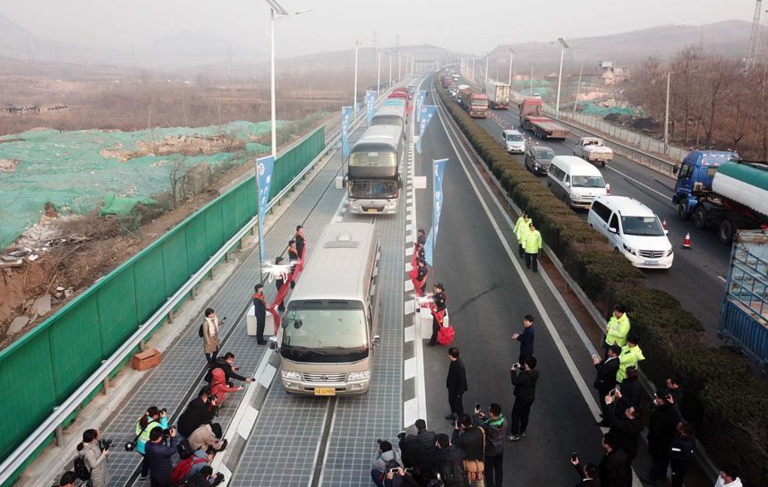

Yesterday, China announced the opening of a 1-kilometer (0.6 mile) solar highway in the city of Jinan, 265 miles south of Beijing.
According to Xinhua, China’s official news agency, the project will serve as a clean energy test bed to evaluate new technologies, with an overarching goal to reduce the amount of land needed for solar farms and transmission wires.
The road surface is made out of panels described as a “transparent, weight-bearing material” that still allows sunlight to pass through. Those panels cover an area comprising almost 1.5 acres. Qilu Transportation Development Group, the contractor leading this project, claims the solar power-generating road can generate 1 million kilowatt hours (kWh) of electricity, enough to meet the power requirements for about 800 households.
For now, the power gained from this project will electrify local highway lights, billboards, surveillance cameras and toll gate entrances. Excess power will be supplied to Jinan’s local grid.
This project’s exact cost was not disclosed by Qilu or local officials, but Xinhua noted that its price tag is about half that of similar projects launched around the world. Quartz has reported that the estimated cost was about $458 per square meter, or a total of $2.7 million.
Similar projects worldwide have succeeded in scoring copious amounts of headlines, as well as questions about whether the benefit of these experiments are really worth their cost. And of course, China has a history of announcing eye-popping infrastructure projects that at first seem a great leap forward for sustainability until they are given a closer once-over. For example, a “straddling bus” last year scored plenty of buzz at first, followed by heaps of ridicule.
Other solar roads built elsewhere have proven to be a mixed bag. A solar bike path in the Netherlands cost an estimated $3.7 million to build. On the plus side, the road near Amsterdam attracted at least 150,000 curious cyclists during its first six months. Indeed, this is an interesting technology for clean technology aficionados, as it could help future engineers develop more resilient and high-performing solar panels. But over that same time span, the road generated only 3,000 kWh – enough to power one home. Those numbers are going to need quite the boost (and costs, including those for maintenance, will have to spiral down) if cities will even come close to the thought of ripping out of asphalt and concrete and replacing them with next-generation solar panels at any point soon.
Last year, the world’s first so-called solar road for cars and trucks opened in France. The same length as the one that launched this week in China, the project in Normandy cost about $6.7 million. This aim of this venture is to gauge whether the panels used on this two-lane road can withstand the weight imposed by thousands of vehicles passing over it day to day. But again, the project raises far more eyebrows than keeping any lights illuminated: the amount of power this project generates is only sufficient to keep the streetlights in the nearby town of 3,300 on at night.
Doubts about this project's efficacy notwithstanding, the Jinan solar road showcases the growth of renewables in China, to the point that the country now is now the world’s largest solar producer. Critics, however, quickly counter that the country by far is still the globe’s largest carbon emitter.
Image credit: Xinhua
2017: The Environment is King, Say Shareholders and Litigants
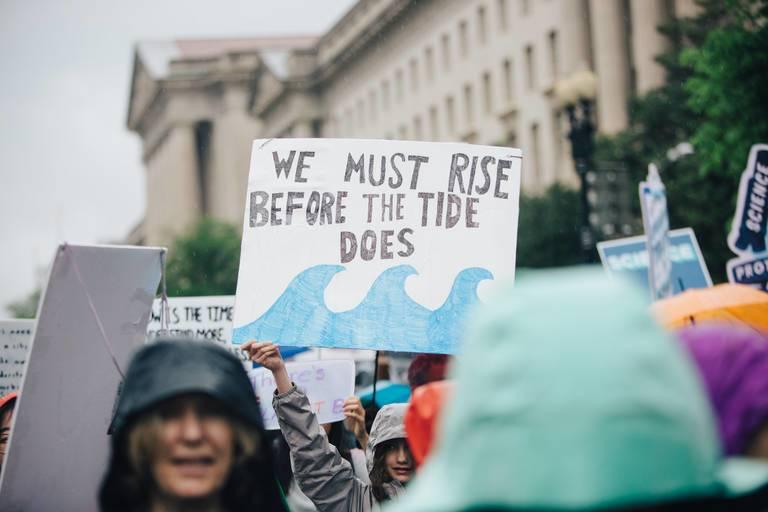

2017 was the year for environmental campaigns, both in North America and abroad. Broad coalitions like the We Are Still In and March for Science signaled, amid loosening of environmental policies in Washington, that the world still supported climate change mitigation and what is more, still believed international consensus was possible.
But bold, public protests on the National Mall were only one indicator this year that climate change remains a fundamental concern across the globe. There has been a growing compendium of research in recent years that implicate oil and gas strategies as the ongoing cause of global warming.
And not surprisingly, there's been growing call by shareholders and asset management companies for industries to be forthright about just what climate change means for those who invest in its future.
Global rallies for science
President Donald Trump's dramatic reduction of funding for federal programs that supported the validity of "climate science" this year not only elicited public comment, it electrified the debate over the role of science in Washington. Some 1 million people attended March for Science rallies across the globe on Earth Day, including 100,000 in Washington DC. According to the University of Delaware Center for Communication, more than 90 percent of those surveyed at the marches felt that the government had a responsibility to consider science based facts in its decision making.
The outpouring of public response on Earth Day set the tone for yet another "rally" barely two months later. Some 2,500 leaders representing a cross-section of governments, businesses and private citizens signed the COP23 or "We Are Still In" declaration on June 5, an answer to the Trump administration's decision to pull the United States out of the Paris Accord.
The March for Science's message was to ensure that science stayed nonpartisan. The COP23 movement, led by leaders from both sides of the political isle, proved that consensus-driven climate action was not only possible, but could continue to grow.
Shareholders take to the floor for climate
But public rallies aren't the only way that Americans have voiced their support for climate-based decisions. Asset management companies, tasked with the safeguarding the value of shareholders' investments, have been speaking out in recent years about the need for oil, gas and other energy industries to embrace both fiscal transparency and divestment from high-emission projects.
“Climate is king … Our research suggests there can be little downside to gradually incorporating climate factors into the investment process — and even potential upside” the BlackRock investment firm wrote in its white paper, Adapting Portfolios to Climate Change last year.
And shareholders have heard the message. Exxon, Occidental Petroleum and PPL, Pennsylvania's largest utility company have registered increasing pressure from investors to inform shareholders of just what prospects climate change may hold for investments in the future.
Lawsuits: the latest arsenal against climate risk
Legal challenges to prove that oil and gas companies have a responsibility for worsening climate change haven't gone well in past years. But the ability of researchers to segregate the causes of carbon emissions and to forecast the environmental impacts has given communities more power in the courts.
CarbonTracker's newest reports on the implications of pollution from high carbon-emitting oil and gas industries has helped highlight the challenges that the global community faces in keeping below a 2 C threshold. The data also calls attention to what communities may face if nations aren't successful in transitioning to a clean energy portfolio.
Communities across that globe have also picked up on that warning. In the US alone, seven cities and counties have sued oil and gas companies this year claiming that the businesses knew their products produced greenhouse gases and increased environmental risks.
The latest, submitted last week by the city and county of Santa Cruz, Calif. strive to encapsulate just what climate change will mean for its coastline.
"Defendants, and each of them, have intentionally, recklessly, or negligently caused flood waters, wildfires, extreme precipitation, landslides, saltwater, and other materials, to enter [the plaintiffs’] property."
Much like private property owners, public entities are viewing the insidious damage from climate change as a kind of private trespass, and holding oil and gas companies responsible for permitting it to happen.
Will the strategy work?
That will ultimately be decided by the courts. But one thing is becoming clear: It's becoming harder for companies to plead ignorance in the face of mounting data.
Cutting-edge research on the nuanced causes of climate change and public advocacy may be next years formidable arsenal against the causes of global warming.
Flickr/Molly Adams
Greenpeace: Beverage Companies Must Do Far More to Curb Single-Use Plastic Pollution
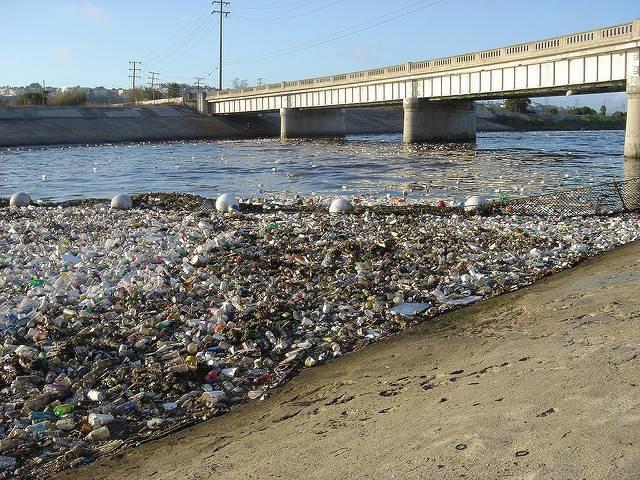

As many of us are still cleaning up and filling our recycling bins in the aftermath of the latest holiday, while preparing for yet another, Greenpeace offers a reminder that pollution from single-use plastic containers still poses a huge challenge – and in fact, the environmental group says three of the world’s largest beverage companies are the worst contributors to this ongoing problem.
Earlier this month, Greenpeace announced it had conducted audits of waste across 31 U.S. cities. As part of the global #breakfreefromplastic
And the three key offenders, concluded Greenpeace, are PepsiCo, Nestlé and Coca-Cola. According to the group’s activists, the results were remarkably consistent, no matter where the plastics were evaluated, from Miami to Long Island to Southern California.
“Companies like Pepsi, Nestlé, and Coca-Cola continue to pollute our communities, waterways, and oceans with single-use plastic that will never disappear,” said Greenpeace Oceans Campaigner Kate Melges in an emailed statement to TriplePundit. “For far too long, these companies have put the onus on consumers to deal with the plastic waste epidemic, but people across the country are starting to take a closer look at the plastic pollution in their local communities to put the responsibility back where it belongs -- on the corporations producing it.”
All three companies insist they are doing more to tackle both the surge in single-use plastic consumption and the corresponding lack of recycling to manage this stream of waste. Coca-Cola, for example, has confirmed that single-use plastic containers are taking up a larger portion of its global packaging; Greenpeace has claimed the results include the company being responsible for the manufacture of up to 110 billion bottles a year.
Meanwhile, PepsiCo announced earlier this year that it has joined the New Plastics Economy initiative, which is led by the Ellen MacArthur Foundation. Nestlé says it seeks to reduce its overall packaging consumption by 140,000 tons before the end of 2020.
Greenpeace, however, has concluded that those waste diversion efforts are not enough to stem the flow of plastic trash into the world’s oceans. The organization’s researchers say 90 percent of plastics produced worldwide are not recycled, and the amount of garbage that winds its way into the seas is the equivalent of one truckload a minute.
The environmental group has taken its argument against excessive plastic consumption a huge step further by claiming that plastics have become a human rights issue. Greenpeace's researchers have alleged that bottling companies are selling products in single-use plastic containers in countries that lack effective waste management systems. Furthermore, the plastic that ends up in landfills or incinerators that are often located close to low-income communities or those where the majority of residents are people of color.
Image credit: Plastic Polluting Coalition/Flickr
The 3 Disruptors Reshaping the Food Industry
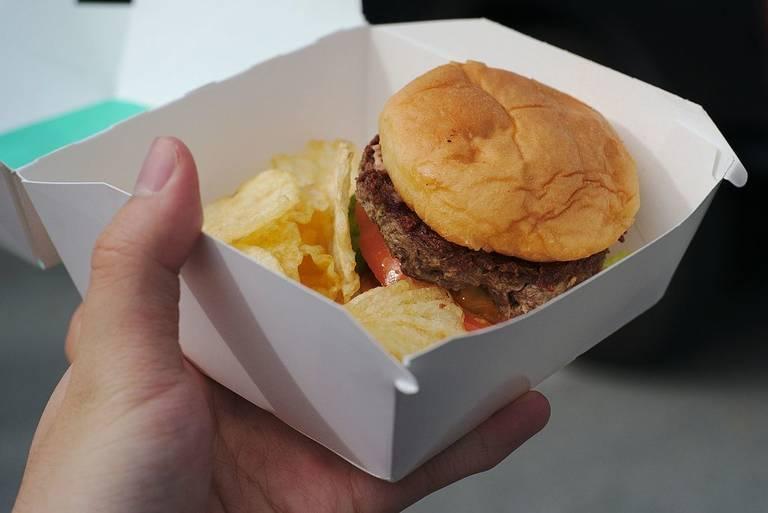

For those who think that eating your veggies is boring, there's good news.
2017 was a banner year for food innovation, particularly when it came to dishes that don't contain the most common allergens, like wheat, corn and soy.
In fact, who would have figured food disruptors could actually make edible things out of pea protein? More to the point: Who'd think we'd like it?
But vegan foods are becoming more than a fad. While the stats still suggest that the number of hard-core vegans is still pretty small (roughly 2 percent), there's another impressive stat that is driving new innovation: The numbers of people who for one reason or another are turning to vegetarian cuisine on either a casual or full-time basis.
Beyond Meat: TGI Friday's new burger
Many Americans wouldn't dare consider a vegan burger fitting to be included on a meat and chicken menu. But in January Beyond Meat's 6-ounce patty will earn an esteemed place at the burger bar. The plant-based sandwich has already passed the muster at six Boston franchises. The product, a meaty, juicy look-alike is the latest vegan concept to become restaurant fare.
For TGI Friday's, which has been working hard to redesign its menu and its appeal, the gluten-free burger offers a unique chance to capture a bit more of today's discerning restaurant customer base.
Pea isolate: impossible edible legume
Beyond Meat wasn't the only company to benefit from the growing interest in plant-based foods. Ripple Milk and Impossible Foods, whose products are both made from pea isolates and other plant substances, are capturing a share of the meat alternatives market as well. And say what you will about beans, green peas and those other foods our mothers used fill our plates with, consumers aren't turning them down.
In fact, Ripple Milk is already seeing a profit from the downturn in conventional milk sales, which is expected to drop more than 10 percent by 2020. With protein content that outstrips both cow's, almond and soy milk, the idea of a milk made from legumes doesn't sound so bad to consumers.
Unlike its main competitor, Beyond Meat, Impossible Foods' burger isn't gluten free. It also isn't based on pea isolate. What it does offer is an intriguing combination of ingredients that many say give it the texture of ground beef. As to its ability to "bleed" like real meat, therein lies Impossible Foods' piece de resistance: replicated heme that's vegan in origin and allows the burger to cook and taste like beef.
Geltor's fake gelatin is building a market of its own
When food disruptors Alex Lorestani and Nick Ouzounov were creating their imitation gelatin product, Geltor (formerly Gelzen), they weren't necessarily trying to compete with ready-made gelatin desserts. They had a much bigger market in mind.
Gelatin, which is commonly made from beef, pork, horse and fish by-products, is used in a large number of processed foods. Everything from candy to canned meat may contain gelatin, a substance that is almost as essential to the food industry as sugar and salt.
But there are compelling reasons for developing a vegetarian equivalent that's made from recombinant proteins. Not only do vegetarians and vegans often shun the thought of eating a meat-based ingredient, but some cultures forbid it. And those who may have ethical compunctions about eating a product made from an animal they can't confirm was treated humanely, may have a problem with the ingredient as well.
For now, Geltor is still grooming its market. Replacing something that has been the go-to ingredient for hundreds of years isn't easy.
Still, if there is any takeaway from this year's boom in artificial meat products, it is the fact that consumers are making informed choices about their foods and in many cases, are willing to opt for processing strategies that allow them to shun meat-based, organic sources. Vegan gummy bears that taste like the old standby may be right around the corner.
Wikimedia image: Dllu
The ‘Resource Curse’ is Alive and Well in the U.S.


When discussing the “resource curse,” we usually think developing nations, as in Middle East oil and gas and the region’s volatile geopolitics; oil’s contribution to social problems in nations such as Nigeria and Venezuela; and the impact that “conflict minerals” has had in countries such as Congo.
But another version of the resource curse, also known as the paradox of plenty that can afflict countries blessed with abundant natural resources, is alive and well in some parts of the U.S., including the Rocky Mountain region.
As economics reporter Andrew Van Dam recently profiled in the Washington Post, Idaho and Wyoming share far more in common than a boundary. In the 19th century, they were even part of the same territory before Wyoming was split off; both became U.S. states in 1890. They share similar topography, are blessed with abundant natural beauty and boast that indomitable frontier spirit and Old West culture.
But Idaho is currently the fastest-growing U.S. state in population, while Wyoming has had the largest population decline (by percentage) out of all the U.S. states during 2017. The state with the second-largest population decline is West Virginia, where the population has decreased to the point that one of its U.S. congressional seats is in jeopardy.
What do Wyoming and West Virginia have in common? Van Dam points out Wyoming and West Virginia are largely dependent on mineral extraction; furthermore, coal mining dominates those states’ economy. Wyoming is the U.S. state most reliant on mining and energy, with over 20 percent of the state’s economy tied to those sectors. West Virginia comes in at third, with 11.5 percent of its economy dependent on the extractives sector. Wedged between them is Alaska, at just over 15 percent.
Meanwhile, while Texas has long enjoyed the reputation as the state with the most robust energy sector, that state’s economy has long been diversified to the point that energy and mining currently comprise just under 7 percent of its total economic output.
Contrast those percentages with Idaho, where less than 1 percent of the economy is driven by mining and energy. But Idaho’s economy has also diversified, with technology, advanced manufacturing, business services and agriculture the main drivers of job growth in the state. The state of 1.7 million has long evolved from its origins, when a gold rush during the 1880s helped set the foundation for statehood. Now, young workers and families are flocking to Idaho’s capital, Boise, where the cost of living is low and jobs are relatively plentiful.
Wyoming, with a population one-third of Idaho’s, has an economy largely centered on energy, tourism and agriculture. What may be a draw for many visitors – cattle outnumbering people two-to-one, plenty of wide open space and a quiet lifestyle – also has a flip side, as in the struggle to attract and keep businesses and entrepreneurs. The state has launched an innovative program that strives to convince former Wyoming residents to move back, but the state’s business and political leaders need more ideas while they sort out how to diversify the state’s business portfolio.
In addition, boom and bust cycles continue to mark Wyoming’s economy. Even though the state’s coal sector has stolen much thunder from Appalachia, prospects for employment in that sector are far from promising – especially since coal in the state’s Powder River Basin is much easier to extract thanks to automation.
Van Dam sums up the economic potential in Idaho and Wyoming, which can also serve as a reminder to states that pin long-term growth on energy:
“It’s the tired old parable of two siblings, separated at birth. One began with natural gifts and found little incentive to grow beyond them, and another was forced to play a weaker hand but became stronger and more resilient in the process.”Image credit: Charles Knowles/Flickr
Santa Cruz County and City Join Efforts to Sue Oil and Gas Companies


Armed with new data that suggests that Central California's rugged coastline will face increasing destruction from climate change in the coming decades, the city and county of Santa Cruz are striking back.
They are joining a growing list of communities across the nation that say that oil and gas companies are largely responsible for global warming, and want legal remedies to offset climate impacts.
The suits by the city and county were filed in the Superior Court of California in Santa Cruz on Dec. 20 and lay out eight causes of action for which they say the 29 companies are responsible. The causes include the failure to warn local residents and trespassing county and city property.
"Defendants, and each of them, have intentionally, recklessly, or negligently caused flood waters, wildfires, extreme precipitation, landslides, saltwater, and other materials, to enter [the plaintiffs'] property," the suits allege.
The litigants also claimed that the "[defendants] knew or should have known, based on information passed to them from their internal research divisions and affiliates and/or from the international scientific community, that the climate effects ... rendered their fossil fuel products dangerous, or likely to be dangerous, when used as intended or misused in a reasonably foreseeable manner."
The city and county are basing their suits in part on a wide range of documents going back to the 1960s that suggest that both the US government and petroleum companies were aware of the possible implications of high-carbon emissions.
These two new suits build on several earlier attempts to recover damages from oil, gas and coal companies, by including more localized data about the environmental impacts the county is facing. By 2030, the lawsuits allege, the region could be looking at a 4-inch rise in sea level. An estimated 850 buildings and $742 million in assets could be at risk from floods in the next decade.
Chevron has called the suits "factually and legally meritless." In a prepared statement last week, it proposed that "reducing greenhouse gas emissions is a global issue that requires global engagement" and that the legal challenges "only serve special interests at the expense of broader policy, regulatory and economic priorities."
According to the Union of Concerned Scientists however, research conducted at the University of California and other institutions has already confirmed that "emissions traced to the companies named in California lawsuits have contributed more than 10 percent of global sea level rise."
Image: Flickr/Dan Dawson
Business Schools Finally Teaching Ethics and Tackling Social Change to MBAs
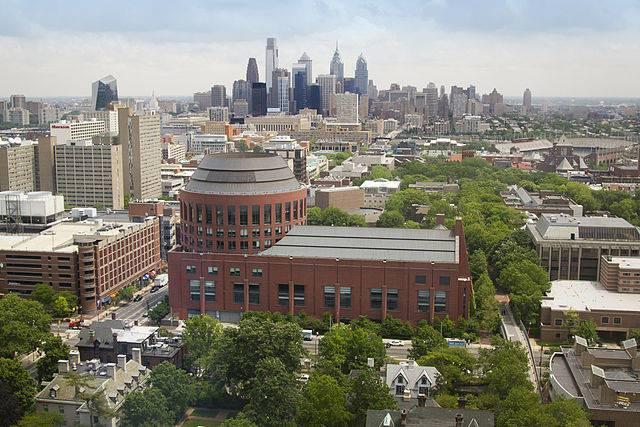

For decades, the business of Master of Business Administration (MBA) programs was strictly business. The requisite finance, accounting and marketing classes dominated curricula as most business schools eschewed discussing ethics and social change. After all, most of these programs had taken the Milton Friedman approach to commerce, as in insisting that companies stick to what they do best: maximizing profits and shareholder value. Friedman did add a caveat to his belief that the pursuit of profits could be pursued “so long as it stays within the rules of the game" - in other words, respect the law. The bottom line for Friedman, however, was that it was up to other institutions to pursue social good.
The past year, however, has proven that it has been business far beyond unusual. And more business schools are realizing that if their students will be engaged and able to thrive in this new reality, then MBA programs must prepare their students for this brave new world.
“As topics like sexual harassment dominate the national conversation and chief executives weigh in on the ethical and social issues of the day,” David Gelles and Claire Cain Miller wrote for the New York Times earlier this week, “business schools around the country are hastily reshaping their [curricula] with case studies ripped straight from the headlines.”
To some critics of the business community, this shift towards more of an emphasis on business ethics has been far too slow, akin to the Titanic trying to change course with the iceberg already in view. Only a few years ago, Bloomberg pointed out that business schools were failing to help foster a more ethical business climate, noting the dozens of top companies that had afoul of laws such as the U.S. Foreign Corrupt Practices Act. Meanwhile, many of these programs have struggled to recruit women to apply to their programs, adding to what many critics say is the lack of diversity within top companies’ c-suites and boards of directors.
A change, however, is underway. Megan Kamerick of Fast Company has pointed out that top business schools, such as at University of Pennsylvania and Columbia University, now require students to take courses on corporate responsibility either as part of their curricula or for orientation.
Much of this evolution has been driven by students themselves. We have known for several years that the younger generation of workers entering the labor market prefer to work for companies that are more responsible and have embarked upon some level of social purpose. And now these future managers want those conversations about ethics and a more inclusive workplace to unfold in the classroom.
This is quite a contrast from even a decade ago, when most business schools - including the program from which I graduated - still limited their curricula to economic theory and case studies. Topics included the classic business cases: Walmart under Sam Walton zooming in on small towns for the opening of new stores, while Kmart only focused on the suburbs; Zara and its parent company, Inditex, harnessing technology to revamp its supply chain; and companies like Arm & Hammer finding new product and business adjacencies.
Now, as the Times profile showcased, current news headlines generate course content for newly minted MBAs. Controversial issues such as dissecting the “bro culture” at the likes of Uber and other Silicon Valley companies, recent NFL protests, the violence last summer in Charlottesville and businesses’ response to it - as well as the #MeToo movement and its role in ensuring a more welcoming workplace - are included in more business schools’ course listings.
Traditionalists may wince at the thought of any graduate-level business course becoming more issues-oriented, but we live in an era in which stakeholders can and will brandish tools such as social media to keep companies accountable. And this business world in which we live and work means that the new challenges businesses face cannot be simply be a can kicked down the road to human resources, communications or legal. All of us have to be a part of the solution, and business schools are wise to prepare their students for this new wave of challenges that will flare up at any time.
Image credit: WestcoastivieS (Wiki Commons)
How Electric Vehicles Can Get Even Cleaner


What does it mean for a vehicle to be emission-free?
Certainly, if you drive an electric car, that would do it, right? After all, there are no emissions coming out of the tailpipe; in fact, there is no tailpipe.
But, according to MANN+HUMMEL, a German producer of air filtration systems, that is not the whole story. Every vehicle produces emissions from tire, brake, and road abrasion. These are particulate emissions, which are some of the most dangerous when it comes to asthma and other health conditions.
Alfred Weber, MANN+HUMMEL’s CEO, has said, "More and more people at our locations ranging from Ludwigsburg to Bangalore and Shanghai are suffering from the consequences of air pollution and who else apart from a filtration expert such as us is going to find a solution?"
The company has just launched a new fine particulate filter system that can be attached to a vehicle, making it truly emission-free. The filters will be attached to five electric StreetScooter test vehicles from the fleet of the Deutsche Post DHL Group in five different German cities. StreetScooter, which manufactures a variety of delivery vans, bikes, and trikes, is a subsidiary of the Deutsche Post DHO Group. The DHL fleet currently includes 5,000 StreetScooter delivery vehicles. StreetScooter is a subsidiary of the Deutsche Post DHO Group.
The company’s commitment to EV’s is demonstrated in this CEO blog, which states, “Now that e-mobility has been given the “green light” by policy makers, it is up to the automobile and logistics industries to work within this political framework to find innovative and effective solutions for environmentally-friendly mobility.”
While the vehicle-mounted filters will not collect all of the particulates produced by the vehicles to which they are mounted, they are expected to collect an amount equivalent to what each vehicle produces.
Here’s how it works. Each vehicle has a blower system attached to the fine particle filter, which is mounted under the body at the height of the rear axle. This location is optimal for collecting particulates. It also does not take up any valuable cargo space. The blower system directs ambient air into the filters. The blowers remain active even when the vehicles are stationary. The filter systems being deployed for the pilot study are all equipped with sensors that monitor their collection efficiency. This data is then sent to the cloud, where it can be visualized via a web interface and then evaluated by filtration experts.
MANN+HUMMEL is reaching out to policy makers, looking to establish regulations limiting total emissions, an achievement that is now possible. Says Weber, “The coming together of the biggest logistics provider, the biggest producer of electric commercial vehicles in Germany and the global filtration expert has made driving and delivery operations possible in city centers which is neutral in terms of emissions."
Werner Spec, mayor of Ludwigsburg, outside of Stuttgart, commented that the only other way to reduce these types of emissions would be a driving ban, a measure that would be far more disruptive.
Image courtesy of StreetScooter.